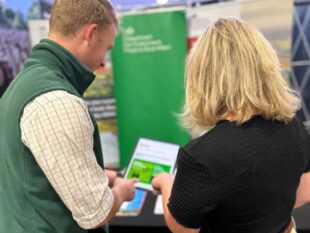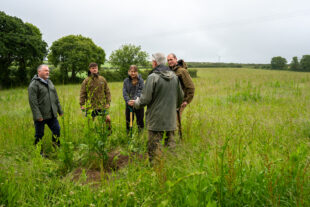
Through the Farming in Protected Landscapes programme (FiPL), farmers and land managers can get funding to deliver projects that support and improve National Landscapes (formerly Areas of Outstanding Natural Beauty), National Parks and the Broads.
In this post, I'll share an overview of the programme and findings from the recently published Farming in Protected Landscapes evaluation.
The findings give a sense of how popular the scheme has been and the reasons behind it.
Background
Protected landscapes span the country, from Cornwall to Northumberland. These unique and special places cover around 25% of England.
The Landscapes Review highlighted that our protected landscapes need to deliver more for environment, people, and place.
FiPL was created to help achieve this, with £100 million committed to the programme between July 2021 and March 2025.
Through FiPL, farmers and land managers in these landscapes deliver projects around 4 themes:
- Nature
- Climate
- People
- Place
So far, around 3,000 projects have been awarded funding.
The programme is managed at a local level by protected landscape organisations (PLOs). FiPL advisers from these organisations help farmers and land managers to develop thier applications and deliver projects.
Projects over £10,000 are reviewed by Local Assessment Panels (LAPs) consisting of local representatives from farming, environmental and community backgrounds.
Projects under £10,000 are reviewed by a senior member of staff in the PLO.
Findings from the evaluation
The evaluation team collected information through participant and non-participant surveys, stakeholder interviews, observations and data analysis. With this information, they highlighted the following.
The programme is popular
There has been high demand for funding through the programme. The participant survey, which received 400 responses, emphasised how engaged people are with FiPL.
Over 85% of respondents said they would recommend the programme to others and 63% said that they are more likely to engage in our schemes in the future because of FiPL.
The adviser role is crucial
The evaluation highlighted that a significant reason for this popularity is the level of on-the-ground and dedicated support from advisers. 92% of participants felt ‘very supported’ or ‘supported’ by their FiPL officer, with participants supported by the same officer throughout the project.
Advisers help to boost project ambition, with the evaluation noting that pre-application site visits act as an opportunity for advisers to stimulate additional project ideas.
The evaluation also highlighted that FiPL officers are successful in encouraging farmers and land managers to take part.
The most common way participants found out about FiPL was through their local PLO team. Additionally, the evaluation highlighted that advisers have been successful in engaging farmers and land managers who hadn't taken part in other agri-environment schemes before.
FiPL advisers' have helped to create positive and collaborative relationships, both between PLOs and farmers and among farmers themselves. 71% of survey respondents stated they are working more with their local PLO than they were before the FiPL programme started. In addition, FiPL advisers have encouraged groups of farmers to work together and submit joint applications.
Analysis of approved projects in September 2022 found 9.7% (approximately 197) were group-based applications. As of March 2023, FiPL had supported the creation of 41 new farm clusters and facilitation groups.
Programme flexibility and bespoke projects are important
In FiPL, farmers and land managers can deliver short-term projects throughout the year.
This allows them to fit applications into busy farming calendars and deliver projects at speed during quieter times of the year.
They can design and combine actions which work within their land management context, help them achieve local and personal goals and aspirations, and achieve greater outcomes. For instance, farmers can use funding to invest in educational infrastructure on their farm, as well as the administrative aspects of getting children onto farms, such as transport.
This ability to combine activities means that the vast majority of projects are multi-theme and, as a result, the programme is delivering on its four themes. The evaluation also highlighted that FiPL is working well alongside other Defra schemes, as FiPL officers will signpost to other schemes if they are more appropriate.
Local Assessment Panels help to achieve value for money
The evaluation noted that Local Assessment Panels are helping achieve value for money and are making decisions effectively. LAP panellists are well balanced in terms of their representation across the four themes of the programme.
This promotes a good balance of different viewpoints. Crucially, panellists are local to the area, which helps ensure projects meet local objectives and achieve local buy-in.
Next steps
We will continue to work with the brilliant PLO teams to improve the scheme, increase uptake and deliver projects in England's most treasured rural areas.
We will spread the word that farmers can take part in both FiPL and our environmental land management schemes, as the evaluation highlighted non-participants feared preclusion from these schemes if they participated in FiPL.
In the Environment Improvement Plan, we committed to ensure that the best concepts of FiPL are integrated within our other schemes. The evaluation team will continue to evaluate the programme, exploring areas such as value for money and project efficacy after an application is submitted.
Finally, we would like to thank the LAP panellists (who are volunteers) and the PLOs for their hard work and dedication in the delivery of FiPL, as well as the farmers and land managers for delivering projects so effectively.




8 comments
Comment by Alistair Crowle posted on
It would be nice to have some actual examples of what has been achieved on the ground.
Comment by The Team posted on
Hi Alistair,
We're going to start publishing 'project spotlight' posts in the new year - they'll be similar to our monthly Landscape Recovery posts.
In each post, the project teams will be able to go into more detail about their landscape, their aims and their work on the ground.
Best wishes,
The Team
Comment by James Hedger posted on
I applied for FiPL funding a couple of years ago to restore a small aqueduct [ the only one in the national park]where a couple of leats crossed to supply a listed local corn mill. It took alot of work to prepare including visits to English Heritage photo library in Swindon. I was turned down as 'not enough points'. English Heritage published a booklet about water meadows and leats saying how important they are to preserve. [they have no funding themselves for this]. I've not found FiPL to be a supportive scheme and sadly the aqueduct has now lost 90% of it's structure. It would have been an interesting local feature for folk as they walk the lanes and engage with local history.
Comment by The Team posted on
Hi James,
Applications are competitive and scored against one another to determine which will deliver the most benefit to the Protected Landscape from their available budget.
Scoring considers how well applications align with and deliver the programme's 4 themes: climate, nature, people, and place – and how it contributes to the Protected Landscape’s management plan priorities. Scoring also incorporates value for money, deliverability, and sustainability.
The Dartmoor landscape team advised that the local assessment panel requested further evidence on some of these areas and this particular application was deferred. If project applications are not approved for funding, applicants may redesign and resubmit their application in line with the Protected Landscape’s requirements. They added that a A FiPL adviser made contact following the outcome of the application to offer their assistance in this regard.
We wish you all the best if you choose design and apply for future FiPL projects.
Best wishes,
The Team
Comment by Ian Plewis posted on
I hope the final evaluation will provide solid evidence about what has changed, especially with regard to 'climate', and whether these changes can reasonably be attributed to FiPL.
Comment by The Team posted on
Hi Ian,
Thanks for your comment. We agree this is important to establish. The next phase of the evaluation will focus on the impact of the programme, in terms of what has been delivered, as well as longer term outcomes where these are available. We will share another blog post with the findings when they are published in 2024.
Best wishes,
The Team
Comment by Alistair Crowle posted on
Great, thanks for getting back to me so quickly and I look forward to seeing further information in due course.
Alistair
Comment by The Team posted on
Just to add - if you would like more information about FiPL projects in the meantime, you can read this FiPL summary report which marks 2 years of the programme and provides case studies: https://www.nationalparksengland.org.uk/__data/assets/pdf_file/0024/475080/0345-NPE-FiPL-report-2023-A4-WEB.pdf
It's also worth noting that each protected landscape publishes details of their projects on their websites.
Best wishes,
The Team